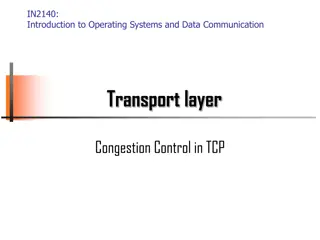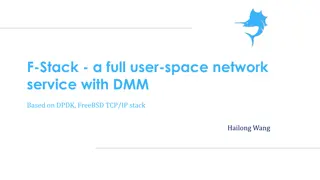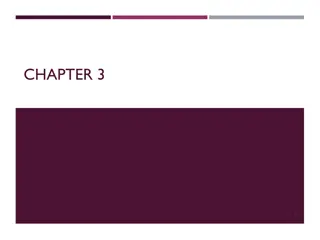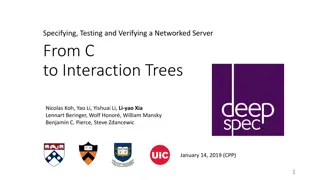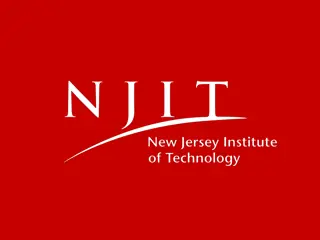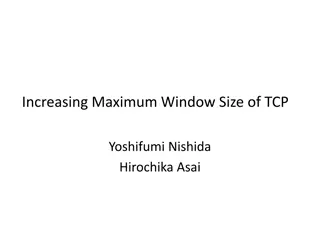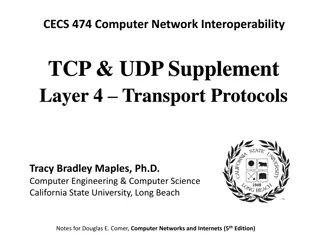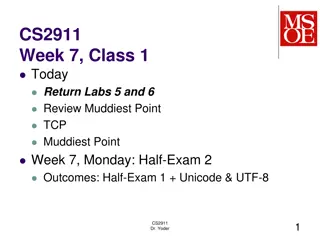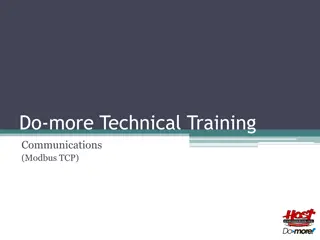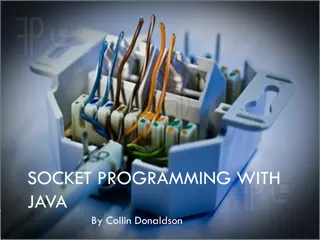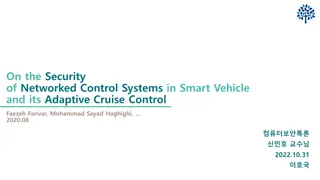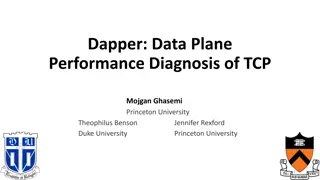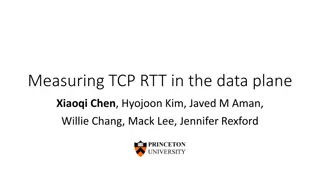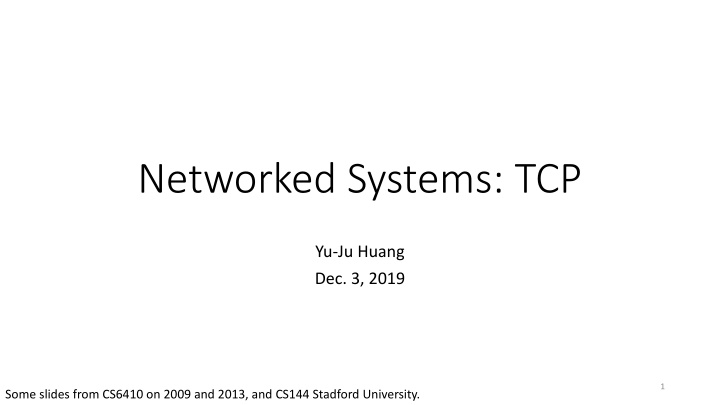
The Evolution of Internet Protocols
Explore the development of Internet protocols from the early stages at MIT, RAND, and NPL to the deployment of TCP/IP in 1983. Learn about key milestones like the birth of the World Wide Web and the design philosophy of DARPA protocols. Delve into the history of networked systems, congestion control, and the end-to-end principle through informative slides and references.
Download Presentation

Please find below an Image/Link to download the presentation.
The content on the website is provided AS IS for your information and personal use only. It may not be sold, licensed, or shared on other websites without obtaining consent from the author. If you encounter any issues during the download, it is possible that the publisher has removed the file from their server.
You are allowed to download the files provided on this website for personal or commercial use, subject to the condition that they are used lawfully. All files are the property of their respective owners.
The content on the website is provided AS IS for your information and personal use only. It may not be sold, licensed, or shared on other websites without obtaining consent from the author.
E N D
Presentation Transcript
Networked Systems: TCP Yu-Ju Huang Dec. 3, 2019 1 Some slides from CS6410 on 2009 and 2013, and CS144 Stadford University.
Outline Network history Network basics Layering End-to-end principle Congestion Avoidance and Control TCP Congestion Control with a Misbehaving Receiver 2
Brief History of the Internet paper: It happened that the work at MIT (1961-1967), at RAND (1962- 1965), and at NPL (1964-1967) had all proceeded in parallel without any of the researchers knowing about the other work. Parallel beginnings Four nodes interconnected (UCLA, SRI, UCSB, Utah) J.C.R. Licklider describes an Intergalactic Network connecting everyone on the globe. (1962) MIT (Leonard Kleinrock) First paper on packet switching theory. (1964) DARPA (Larry Roberts) plans for ARPANET . RAND (Paul Baran) Packet switching for survivable networks. WAN connects two time-sharing computers - btw Mass. and Cal. (circuit switching) NPL, UK (Donald Davies) Packet network. 1960 1965 1966 1968 1969 3
TCP/IP deployed (1983) New networks appear: ALOHAnet, Cyclades, IBM SNA. First public demonstration of this network technology. Also, electronic mail was introduced. (1972) World Wide Web, by Tim Berners- Lee, became publicly available (1991) Internetting and TCP born (DARPA), led by Vint Cerf and Bob Kahn. (1974) 1st Web browser, Mosaic, by Marc Andreessen (1993) 1990 1970 1980 From CS144, Stanford University with modification, source from Wikipedia 4
Useful References 1. The Early History of Data Networks G. J. Holzmann, B. Pehrson, IEEE Press 1994. 1. The Design Philosophy of the DARPA Internet Protocols. D. Clark, ACM Sigcomm 1988 2. Brief History of the Internet B. M. Leiner, V. Cerf, D. D. Clark et al. http://www.internetsociety.org/internet/internet-51/history-internet/brief-history-internet 5
Design Philosophy of DARPA Internet Protocols Top level goal: effective technique for multiplexed utilization of existing interconnected networks The Internet must (sorted based on importance) continue despite loss of networks or gateways support multiple types of communications service accommodate a variety of networks permit distributed management of its resources be cost effective permit host attachment with a low level of effort resources used in the internet architecture must be accountable 6
Design Philosophy of DARPA Internet Protocols Top level goal: effective technique for multiplexed utilization of existing interconnected networks The Internet must (sorted based on importance) continue despite loss of networks or gateways state information which describes the on-going conversation must be protected support multiple types of communications service TCP, UDP accommodate a variety of networks including military and commercial facilities 7
Network Layers Layering principle End-to-end principle IP layer: best-effort delivery TCP Guaranteed in-order delivery From Wikipedia 8
Router - Lookup and Forward From Wikipedia Data H Queue Packet Lookup Address Destination Address Egress link Forwarding Table Buffer Memory 9 From CS144, Stanford University
Congestion Avoidance and Control (SIGCOMM 88) Van Jacobson Adjunct professor at UCLA One of the primary contributors to the TCP/IP protocol stack 10
Problems A series of congestion collapses in Oct. 1986 Data throughput from LBL to UC Berkeley dropped from 32 Kbps to 40 bps 11
Analysis Conservation principle break A new packet isn t put into the network until an old packet leaves Possible failure reasons 1. The connection doesn t get to equilibrium Equilibrium: running stably with a full window of data in transit 2. A sender injects a new packet before an old packet has exited 3. The equilibrium can t be reached because of resource limits along the path 12
Getting to Equilibrium: Slow-start Self-clocking Use ACK as the clock So, how to start? 13
Getting to Equilibrium: Slow-start (2) Slow start Start from cwnd=1 Increase cwnd by 1 for each ACK Slow start but grow fast! 14 After Before
After Slow-start How to converge to equlibrium? Key insight: when congestion happens, packets drop Packet drop reason: insufficient buffer Question How to know when packets drop? How to adjust cwnd gracefully? 15
How to know when packets drop? Use timeout! Timeout causes retransmission If timeout is not well estimated, a sender will injects a new packet before an old packet has exited Timeout value is related to round-trip time (RTT) RTT changes dynamically EstimatedRTT = * EstimatedRTT + (1 ) * MeasuredRTT Timeout value = * EstimatedRTT Before Mistake: not considering RTT variation Propose a cheap method for estimating variation After 16
How to Adjust cwnd Gracefully? Congestion Avoidance Cannot grow like slow-start, it s too fast Need a way to backoff Additive increase / Multiplicative decrease (AIMD) On no congestion cwnd = cwnd + u (u > 0) On congestion cwnd = d * cwnd (d < 1) 17
Put It All Together Start with cwnd = 1 Slow start: Increase cwnd by 1 for each ack On a timeout ssthresh = cwnd / 2 cwnd= 1 cwnd < ssthresh: cwnd += 1 for each ack (slow start) cwnd > ssthresh: cwnd += 1 / cwnd for each ack (additive increase) 18
AIMD Analysis Analysis of the Increase and Decrease Algorithms for Congestion Avoidance in Computer Network , Dah-Ming Chiu and Raj Jain (1989) Criteria Quick convergence Efficiency: high utilization Fairness: each end-host gets fair-share Equi-fairness line Optimal point 19
20 https://en.wikipedia.org/wiki/TCP_congestion_control#Algorithms From CS6410 on 2013.
Other Congestion Control Mechanism Timeout or duplicate ACK are actually implicit notification Explicit congestion notification (ECN) Rate Control Protocol (RCP) Router divides outgoing link bandwidth equally among all the flows Encode the rate in packet header XCP Router encode hints in packet and let sender know how to adjust cwnd Datacenter TCP (DCTCP) 21
DCTCP algorithm Sender side Receiver side Mark ECE only when CE packet is received send immediate ACK when CE state is changed (regardless of delayed ACK) 1. Maintain the fraction of ECN marked seg. for each RTT and update average fraction of marked seg. ( ) w Delayed ACK wo Delayed ACK S S R R 2. Adopt alpha to cwnd decrease Immediate ACK CE (Congestion Experience) ECE (ECN Echo) 22 Slide from https://slideplayer.com/slide/4764537/
TCP Congestion Control with a Misbehaving Receiver (SIGCOMM 99) Stefan Savage, PhD at UW, now Professor at UCSD Neal Cardwell, MS at UW, now at Google David Wetherall, Professor at UW, now at Google AI Tom Anderson, Professor at UW Images from Amazon 23
Misbehavior on TCPs congestion control TCP mechanisms implicitly rely on both endpoints to cooperate in determining the proper rate at which to send data TCP's vulnerabilities arise from Unstated assumptions Casual specification Congestion control that are backward compatible with previous TCP Proposal: designing robust protocols Principle 1: Every message should say what it means Principle 2: The conditions for a message to be acted upon should be clearly set out Principle 3. If the identity of a principal is essential to the meaning of a message, it is prudent to mention the principal's name explicitly in the message. 24
ACK division TCP spec During slow start, TCP increments cwnd by at most SMSS bytes for each ACK received. During congestion avoidance, cwnd is incremented by 1 full- sized segment per round-trip time (RTT). Attack Upon receiving a data segment containing N bytes, the receiver divides the resulting ACK into M separate acknowledgments Misbehavior: cwnd=4 instead of 2! 25
ACK division - Solution This vulnerability arises from an ambiguity about how ACKs should be interpreted Two solutions modify the congestion control mechanisms to operate at byte granularity virtually identical to the "byte counting" modifications to TCP discussed in [Al198, A1199] guarantee that segment-level granularity is always respected only increment cwnd by one SMSS when a valid ACK arrives that covers the entire data segment sent In Linux 2.2.x 26
DupACK spoofing TCP fast recovery Set cwnd to ssthresh plus 3*SMSS For each additional duplicate ACK received, increment cwnd by SMSS Attack Upon receiving a data segment, the receiver sends a long stream of acknowledgments for the last sequence number received 27
DupACK spoofing - Solution This vulnerability arises from the meaning of a duplicate ACK is implicit, dependent on previous context, and consequently difficult to verify. Solution Two new fields into the TCP packet format: Nonce and Nonce reply Sender: fills the Nonce field with a unique random number Receiver: echoes the nonce value by writing it into the Nonce Reply 28
Optimistic ACKing TCP spec assumption that the time between a data segment being sent and an ACK is at least one round-trip time. Since TCP's congestion However, there is no mechanism to enforce this assumption Attack Upon receiving a data segment, the receiver sends a stream of ACKs anticipating data that will be sent by the sender 29
Optimistic ACKing - Solution The optimistic ACK attack is possible because ACKs do not contain any proof regarding the identity of the data segment(s) that caused them to be sent Solution Cumulative Nonce Last ACK s cumulative nonce value is incorrect (156 instead of the expected value of 149) 30
Recap Congestion control Slow-start RTT estimation using variation AIMD TCP attack ACK division DupACK spoofing Optimistic ACKing 32
Perspective There are 4.1 billion Internet users in the world as of December 2018 compared to 3.9 billion Internet users in mid-2018 and about 3.7 billion Internet users in late 2017 Mobile traffic is responsible for 52.2 percent of Internet traffic in 2018 compared to 50.3 percent from 2017 33 Numbers from https://hostingfacts.com/internet-facts-stats/
Thanks! 34





